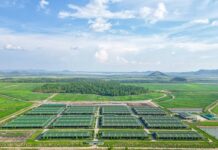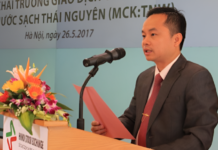 |
Briefing by Minister of Natural Resources and Environment, Dang Quoc Khanh, on the roadmap to complete the construction of the National Land Database by 2025On the morning of July 19, Prime Minister Pham Minh Chinh, Chairman of the National Committee on Digital Transformation, chaired a conference of the Government’s Standing Committee on Digital Transformation with ministers, heads of departments, and chairmen of the People’s Committees of provinces and centrally-run cities. |
At the conference, Minister of Natural Resources and Environment, Dang Quoc Khanh, reported on the roadmap to complete the construction of the National Land Database by 2025, providing information on the development of legal frameworks for the establishment and operation of the National Land Information System and the National Land Database.
According to the report, the Ministry of Natural Resources and Environment is currently advising the Government on a decree regulating land surveys, land-use right registration, ownership of assets attached to land, and the land information system, along with guiding circulars for implementation.
Regarding the deployment of the project, the ministry has established a steering committee, a working group, and regulations on the steering committee’s activities to direct, urge, and guide localities to accelerate the progress of completing the land database, ensuring that by 2025, the land database in localities will be completed for connection and integration into the national land database.
All 63 provinces and centrally-run cities are in the process of constructing and perfecting their land databases.
Reporting on the results of the construction of the National Land Database, Minister Dang Quoc Khanh said that at the central level, four land data blocks managed by the central government have been built and put into management, operation, and exploitation. These include databases on land statistics and inventory, land use planning, land prices, and land surveys and evaluation.
Regarding local-level progress, all 63 provinces and centrally-run cities are constructing and perfecting their land databases. Out of 705 district-level units, 455 have completed the land database with more than 46 million land plots put into operation for state management of land and handling of land-related administrative procedures for people and businesses. Additionally, 705 district-level units have completed the land statistics and inventory database (from the 2019 inventory period) and put it into uniform operation from the central to local levels. Furthermore, 300 out of 705 district-level units have completed the construction of the land price database.
In terms of connecting, sharing, exploiting, and utilizing information in the land database and deploying essential public services, all 63 provinces and centrally-run cities have connected and shared the National Land Database with the National Population Database, along with the land data of 461 out of 705 district-level units and 6,198 out of 10,599 commune-level units, on the platform of shared connection, integration, and data sharing at the national level.
Regarding essential public services, all 63 provinces and centrally-run cities have deployed the procedure “Registration of land-use right changes and ownership changes of assets attached to land due to changes in information of the certificate grantee” on the Ministry of Natural Resources and Environment’s concentrated administrative procedure handling information system, the National Public Service Portal, and integration with the administrative procedure handling information systems of provinces and centrally-run cities.
In the first six months of 2024, 26,487 dossiers were processed for this procedure. Another procedure, “Registration of land-use right changes and ownership changes of assets attached to land in cases of transfer, lease, sublease, inheritance, gift of land-use right, and ownership of assets attached to land,” was also deployed…
Regarding the work of enriching and cleaning up land and housing data, the ministry has completed the “Construction of a solution for cleaning up land data and housing information in the National Land Database.” Four documents (procedures, plans, and coordination guidance) have been issued on piloting the enrichment and cleaning of land and housing data in Hanoi and Ha Nam provinces.
The ministry has directed the Department of Digital Transformation and Data Information of Natural Resources and Environment and the Department of Land Registration and Land Information to coordinate closely with the C06 Department of the Ministry of Public Security, the Departments of Natural Resources and Environment, and related units to complete the tasks, evaluate the results, and seek opinions on the draft procedures and technical solutions for data cleaning. After compiling and finalizing, they will coordinate with relevant units to pilot the implementation in Dong Nai and Binh Duong provinces, and then report and advise on nationwide implementation.
Regarding the construction of a national address database, the ministry has assigned the Department of Land Registration and Land Information to take the lead in supplementing regulations on the address number of land plots and assets attached to land. Accordingly, the draft decree stipulates that the National Land Database contains data on the address number of land plots and assets attached to land, which has been reported by the Ministry of Natural Resources and Environment to the Government and the Prime Minister for consideration. The Ministry of Natural Resources and Environment is responsible for constructing, providing, and sharing data on the address number of land plots and assets attached to land, contributing to the National Address Database.
Constructing solutions and connecting resources suitable for each locality
Reporting on the roadmap to complete the construction of the National Land Database by 2025, Minister Dang Quoc Khanh informed that for the Multi-purpose National Land Information System (MPLIS), the system will be perfected, with training and guidance provided, and put into operation in the third and fourth quarters of 2025.
After 2025, the focus will be on digitizing, constructing, and perfecting the database in areas where it has not yet been built, updating and rectifying outdated data, and thoroughly operating the National Land Database in regular work, connecting and sharing data with other national databases, ministries, sectors, and localities to serve administrative procedures, ensuring “accuracy, completeness, cleanliness, and liveness.”
Minister Dang Quoc Khanh affirmed that the National Land Database will be ensured in terms of information security and will be connected and shared in accordance with regulations with the National Population Database and other databases and information systems of ministries, sectors, and localities.
Minister Dang Quoc Khanh acknowledged that while the construction and operation of the land database have achieved certain results, it has not yet met the requirements. He frankly pointed out difficulties and obstacles, including limited attention and investment in resources for the construction of the land database by localities, which are not commensurate with the requirements and assigned tasks, leading to slow progress in some localities.
Land-related documents and records were formed in different periods, resulting in inconsistent data. The data is extensive and complex, including both spatial graphic data and attribute data with numerous information fields, and many dynamic information fields, making the construction of the land database challenging.
The professional qualifications of officers in charge of constructing, managing, and operating the land database at the central and local levels are currently limited. Infrastructure, information technology equipment, and work on ensuring the safety and security of information in localities have not yet met the requirements, posing difficulties for operation, connection, and sharing with other information systems.
The progress of deploying public services depends largely on the determination and involvement of localities. In addition, the procedures for handling land-related administrative procedures are complex and cumbersome for people and businesses when implemented in an online process.
Based on these issues, to achieve the set goals and roadmap and accelerate the progress of constructing and operating the National Land Database as required, the Minister of Natural Resources and Environment proposed that the Government and the Prime Minister continue to direct the People’s Committees of provinces and centrally-run cities to focus on directing and organizing the implementation of several tasks and solutions. These include concentrating on directing and building implementation plans with feasible solutions and resources suitable to the conditions of each locality to complete the land database in the area and connect and integrate it with the National Land Database by 2025.
It is necessary to review and evaluate the technical infrastructure and software of the land information system currently operating in the locality to have a plan to upgrade, perfect, and maintain the system, in coordination with the Ministry of Natural Resources and Environment, to meet the requirements of land management in the present period.
Localities should coordinate with the Ministry of Natural Resources and Environment to connect and integrate with the National Land Database, deploy the connection and sharing of land-related information and data in the locality with the national databases and specialized databases of ministries and sectors to facilitate the implementation of administrative procedures in the digital environment.
There is a need to continue reviewing and restructuring the processes and operations of land-related administrative procedures provided on the public service portal to ensure practicality, simplicity, convenience, and ease of access and use for people and businesses in receiving and handling public services related to land.
Localities should arrange sufficient budget funds from local budgets for land surveying, mapping, land-use right registration, land-use right certificate issuance, and land database construction, in accordance with the Prime Minister’s Directive No. 01/CT-TTg dated January 3, 2018, on strengthening and improving the efficiency of land management and the construction of the land information system. Priority should be given to budget allocation for the construction of the land database.
It is essential to enhance training and professional guidance to improve the capacity of the team of officers in charge of constructing and operating the land database and providing online public services related to land for people and businesses.
Ensuring Effective Implementation of the Land Law 2024
According to Deputy Minister of Natural Resources and Environment, Le Minh Ngan, the workload for preparing the necessary content to ensure the effective enforcement of the Land Law 2024 from January 1, 2025 is significant, as it requires the completion of 9 Decrees, 6 Circulars, 1 Prime Minister’s Decision, and 18 detailed local provisions.








































